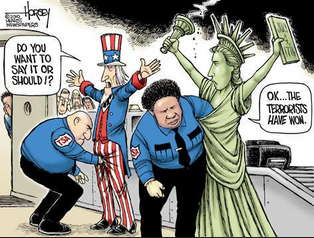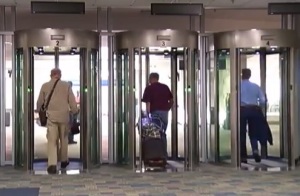 The federal courts have had a very difficult time figuring out how people can seek redress against the TSA, either via policy challenge or challenge to specific abusive interactions with screeners. The Third Circuit of the U.S. Court of Appeals, which services New York armpits New Jersey, Delaware, and Pennsylvania, has taken that challenge to the next level with two decisions that work together to make it very, very hard for someone who was abused by TSA screeners to win a lawsuit.
The federal courts have had a very difficult time figuring out how people can seek redress against the TSA, either via policy challenge or challenge to specific abusive interactions with screeners. The Third Circuit of the U.S. Court of Appeals, which services New York armpits New Jersey, Delaware, and Pennsylvania, has taken that challenge to the next level with two decisions that work together to make it very, very hard for someone who was abused by TSA screeners to win a lawsuit.
[Edit – The media is reporting the ruling as “TSA agents can’t be sued for false arrests, abuse, or assault.” I disagree with this conclusion. Read on…]
Vanderklok v. United States (.pdf), 868 F.3d 189 (3rd. Cir. 2017) was, relevant to the discussion, a suit against a TSA screener himself. The plaintiff alleged, in brief, that a TSA screener got annoyed with him and told the cops he made a bomb threat, resulting in the plaintiff’s arrest. Vanderklok made a First Amendment claim, arguing that his words were what annoyed the screener, and therefore the screener having him arrested violated his free speech.
Constitutionally-oriented lawsuits against individual government agents are generally known as “Bivens” lawsuits, and the idea is that if the Constitution provides a right, then it implies that the courts should be able to hear a case against someone who violates those rights. The Third Circuit took to heart the U.S. Supreme Court’s direction that lower courts should hesitate to allow new kinds of Bivens lawsuits, and thus ended Vanderklok’s First Amendment challenge. There is a long test the Supreme Court uses to counsel as to when Bivens should be extended to another area, but the most important part of this test is whether Congress has created some other kind of remedy. If there’s another way to sue and be made whole, Bivens isn’t necessary. Despite it being doubtful that there was another way to sue, the Vanderklok court emphasized that “TSA employees are not trained on issues of probable cause, reasonable suspicion, and other constitutional doctrines that govern law enforcement officers,” and therefore should be off the hook for retaliation claims because they don’t know any better. (Don’t hurt yourself trying to appreciate the wisdom in that one.)
Poorly reasoned, but fine, if there is another way to sue. The Third Circuit resolved that issue today.
Pellegrino v. TSA (.pdf), 15-3047 (3rd Cir., July 11th, 2018) addressed the only potential other way to sue. Relevant to the discussion, it was a suit against the TSA itself (as opposed to Vanderklok, where an individual screener was sued). Suits against the government for money damages come under the Federal Tort Claims Act (FTCA), a law written by Congress discussing the terms under which one may use the federal courts for such a suit. The predicate for Pellegrino’s claim was similar to Vanderklok’s: a screener, annoyed with her, had her falsely arrested by the cops.
The FTCA allows for most types of personal injury claims (including civil rights staples like assault, false arrest, etc.) so long as the injury was caused by “any officer of the United States who is empowered by law to execute searches, to seize evidence, or to make arrests” (28 U.S.C. § 2680(h)). However, the courts have been hesitant to find that TSA screeners are covered by this law, notwithstanding the fact that their job is literally to execute searches, because TSA searches are, in the courts’ view, different from traditional law enforcement searches. The Eleventh Circuit tossed several FTCA claims against the TSA of mine a few years ago, holding that TSA screeners are not “officers of the United States” (despite their job title literally being Transportation Security Officer). Corbett v. TSA, 568 Fed. Appx. 690 (11th Cir. 2014).
Today’s ruling in Pellegrino does the same, although for different reasoning. The Third Circuit found that the language the FTCA uses implies that Congress only intended it to cover law enforcement officers, and TSA is not law enforcement. This ruling has 2 problems: 1) Congress’ intent is only relevant where the statute is ambiguous. It strains credulity to argue that TSA screeners are not “empowered by law to execute searches,” in my view, but the Third Circuit concluded that “searches” is ambiguous enough to need to examine Congressional intent, 2) The FTCA was written before the TSA was created, so therefore Congress could not have had intent to exclude or exclude them, and 3) since Vanderklok foreclosed Bivens suits, there is now no recourse for those injured in the ways that Vanderklok and Pellegrino were injured.
Put another way, in New Jersey, Delaware, and Pennsylvania, there is now no recourse if a TSA screener intentionally, falsely calls the cops and says you threatened to blow up the airport, because they decided they don’t like your attitude. If you spend the night in jail because a TSA screener lied, you’ve got no lawsuit. Not against the TSA, the TSA screener, and probably not against the cops either.
The rulings don’t directly address more traditional Bivens claims, such as one for assault or false arrest. If a TSA screener beats you or physically restrains you, you may (may!) still have a suit in the Third Circuit. But malicious prosecution, retaliation, defamation, invasion of privacy, emotional distress, and conspiracy to do any of the same? Congress intended that the TSA not be held accountable for that, says the Third Circuit.
The decision was a 2-1 panel opinion, with a well-reasoned dissent to the now binding law in that circuit (long, but worth a read). I look forward to the plaintiff’s motion for rehearing en banc (by the full Third Circuit), for which I’ll be writing an amicus brief.






 About a couple weeks ago, the TSA announced that it would be
About a couple weeks ago, the TSA announced that it would be 







